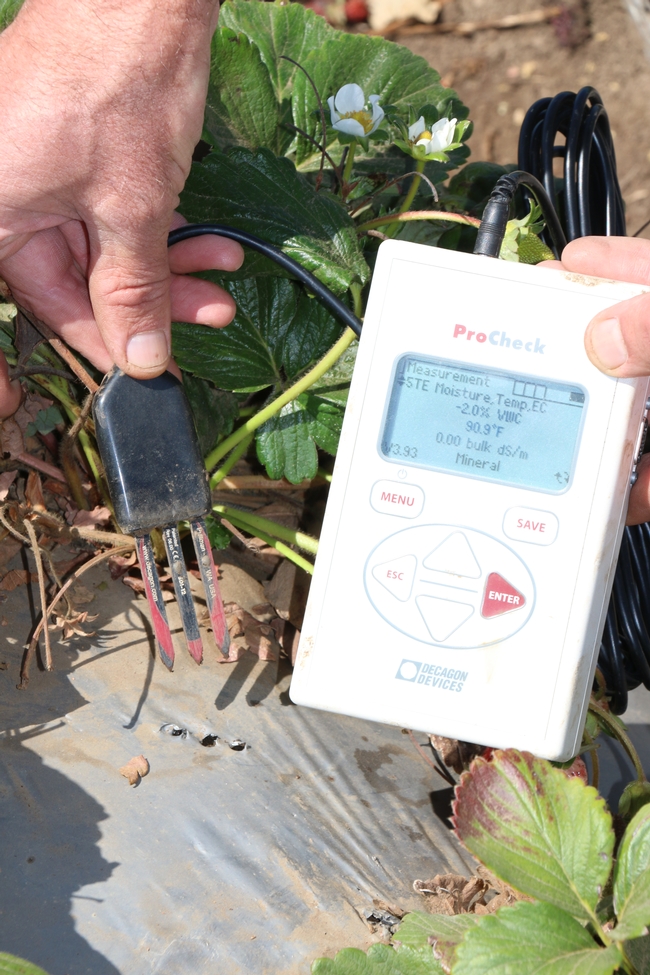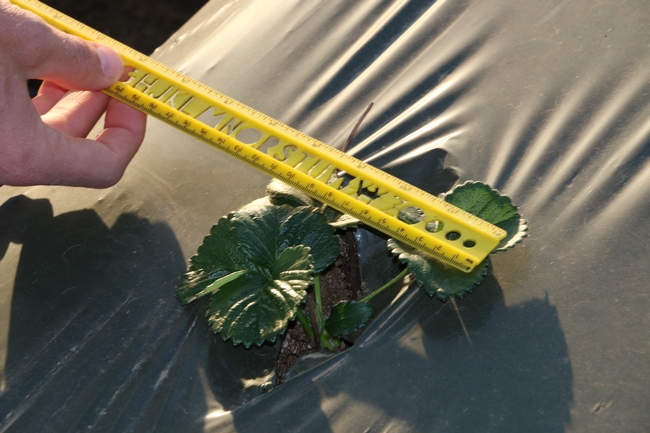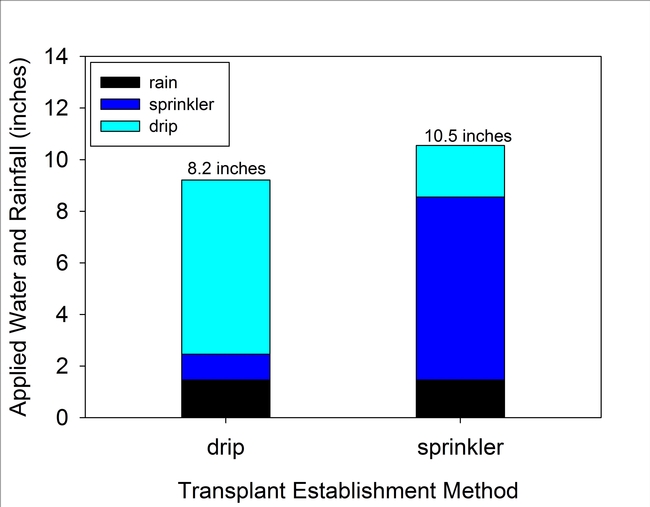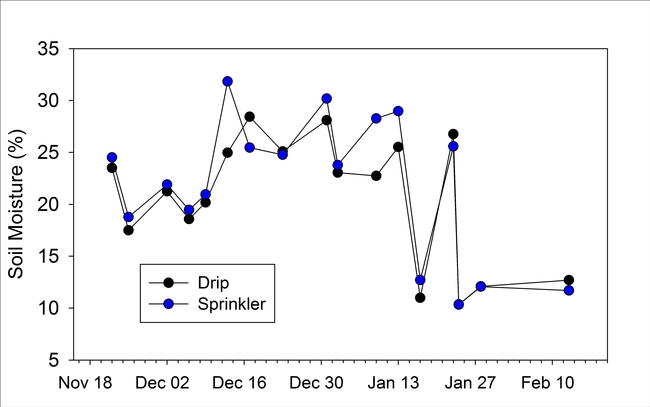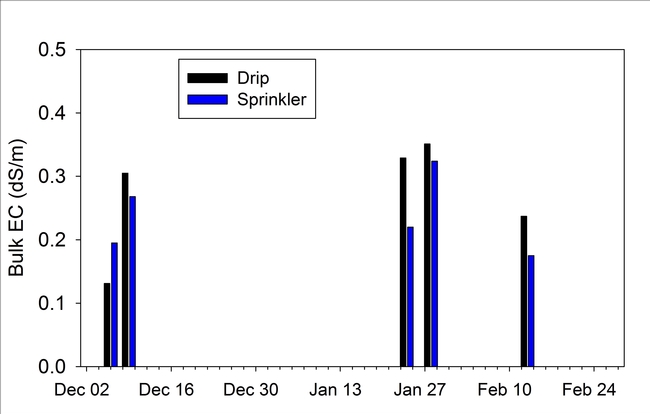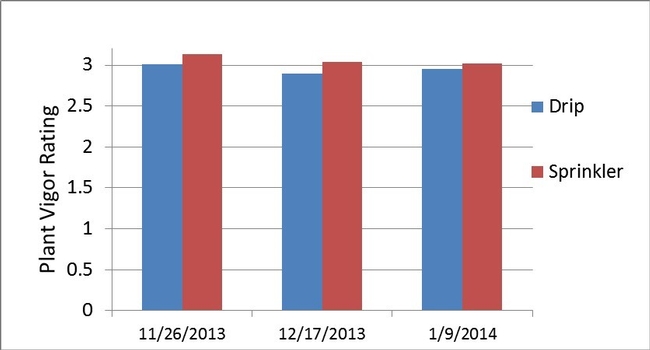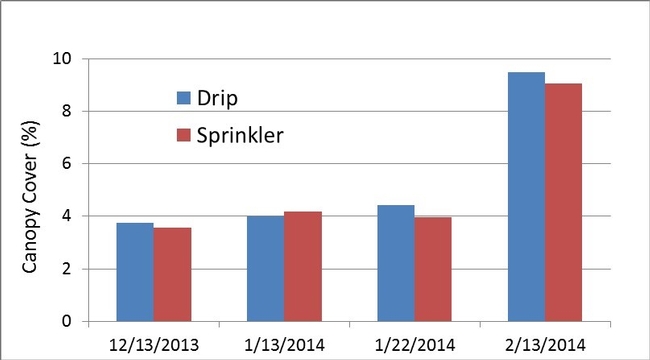Establishing strawberry transplants using drip has several potential advantages compared to overhead sprinklers. Irrigation run-off can be greatly reduced, which protects surface water quality. Some growers have found that they can save water using drip for transplant establishment, and save costs associated with using overhead sprinklers. Often nitrogen fertilizer can be spoon fed to the crop through the drip system earlier in the season than in fields established with sprinklers, thereby reducing the reliance on pre-plant fertilizers that may result in nitrate leaching losses.
Nevertheless, growers are concerned that irrigating transplants using mainly drip may result in less vigorous growth and more dead plants during the establishment period, and yields during the production season will be lower than crops established with sprinklers. One of the specific concerns is that the drip lines adjacent to plant rows may not be as effective in leaching salts from the root zone of young plants as overhead sprinklers. Another worry is that if the transplants are not properly planted and gaps exist between the root crown and the soil, moisture will not move toward and imbibe young roots, and the plant may be set back or die.
Last year was challenging for establishing strawberries is many fields on the Central Coast due to the lack of rain, which normally helps to leach salts that may accumulate around young strawberry transplants. However, these challenging conditions were perfect for comparing vigor and yield of strawberries established using drip and overhead sprinklers.
Field trial description
We conducted a demonstration trial at a ranch in North Salinas beginning November 13, 2013. Soil was a loam texture. The field was planted with UC Albion variety in 2 rows on 52-inch wide beds. Two plots, each of approximately 1-acre in size, were located adjacent to each other in one of the irrigation blocks. Transplants were established using drip in one of the plots and with overhead sprinklers in the other plot. The irrigation foreman made all decisions on how long and often to irrigate both plots. Overhead sprinklers were used for the first 2 irrigations in the drip plot to assure that the transplants were in good contact with the soil. All subsequent irrigations were made using 2 lines of drip tape per bed. In the plot established with overhead sprinklers, transplants were also irrigated twice using the drip system. The last sprinkler irrigation was on January 25th, after which both plots were irrigated with only drip.
Applied water was monitored using flow meters installed on the drip submain and on the sprinkler main line until the end of February. Soil moisture was evaluated in the upper 6 inches of soil next to the transplants using a volumetric moisture sensor at weekly intervals during establishment. Soil salinity was also periodically monitored to a 4 inch depth next to the transplants using a soil salinity sensor (Fig 1.), or by sampling soil and analyzing saturated paste extracts for salts. Plants were rated for vigor and evaluated for canopy cover until mid February (Fig 2.). Marketable fruit yield was evaluated between late April and mid July.
Figure 1. A 5TE decagon probe was used to measure bulk salinity near strawberry plants.
Figure 2. Transplants were periodically evaluated for canopy size by measuring plant width or using a multi-spectral NDVI camera.
Results
Applied water during transplant establishment was about 25% less for the drip treatment compared to the standard sprinkler treatment. As shown in Fig. 3, irrigation water applied to the drip treatment equaled 6.8 inches between Nov. 13 and Feb. 20th. During the same period, water applied in the sprinkler treatment equaled 9.1 inches. An additional 1.5 inches of rainfall were also measured during this period. Estimated evapotranspiration (ET) losses during establishment were 3.2 and 1.1 inches for the sprinkler and drip treatments, respectively. The lower estimated ET amount for drip was due to less wetting of the furrows than in the sprinkler treatment.
Figure 3. Irrigation water and rainfall for the drip and sprinkler treatments between Nov. 13 and Feb. 20th.
Soil moisture measured near the transplants was similar among the drip and sprinkler establishment treatments except for 4 dates between mid December and mid January when the sprinkler plot had higher soil moisture levels than the drip plot (Fig 4).
Figure 4. Volumetric soil moisture measured next to transplants for the drip and sprinkler treatments.
Bulk electrical conductivity (EC), an indirect measure of soil salinity, was slightly higher next to the drip established transplants than the sprinkler established transplants for 4 of 5 dates measured between December and early February (Fig. 4). Bulk EC values were generally low for both treatments, which was confirmed from the saturated paste extracts of soil sampled on January 24 2014 (3rd evaluation date). The EC of the saturated paste extract was 0.80 and 1.83 dS/m, respectively, for the sprinkler and drip established plots. Saturated pasted extract values below 2 dS/m would not be expected to harm strawberry plant growth. Plant vigor (Fig. 5) and canopy cover (Fig. 6) were not different between the sprinkler and drip establishment treatments. Likewise cumulative fruit yields (Fig. 7) were the same for the two methods of irrigation establishment.
Figure 5. Bulk electrical conductivity of the soil adjacent to strawberry transplants, measured using the Decagon 5TE probe.
Figure 6. Plant vigor of drip and sprinkler established transplants, where 0 equates to dead or dying plants, and 5 signifies all plants are very healthy.
Figure 7. Percentage of ground shaded by leaves, measured using a multi-spectral infra-red camera.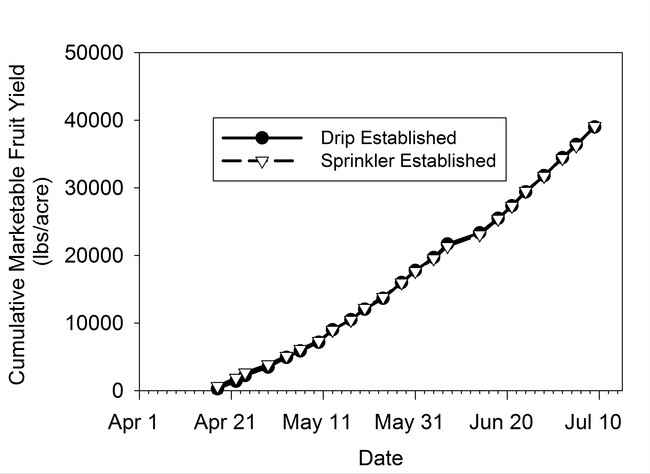
Figure 8. Cumulative marketable fruit yield for sprinkler and drip established plants.
Discussion and Conclusions
The results of this field trial demonstrated that drip can be successfully used to establish strawberry transplants during the winter on the Central Coast, even during drought conditions when rainfall is minimal. Marketable fruit yields were the same between the drip and sprinkler established plots. Additionally, 25% less water was used under drip than in the sprinkler plots during the initial establishment phase. Salinity was maintained at a sufficiently low level in the soil as to not impair transplant vigor and initial growth under drip.
Low water demand of plants during the late fall and early winter is an import factor that helped us successfully establish plants using drip. New transplants have few leaves and reference evapotranspiration, on average, is less than 0.07 inches per day. Since water demand is low, the main purpose of irrigation during establishment is to keep crown roots hydrated and to leach salts from the root zone. Using good planting techniques is critical to successfully using drip for establishment. Transplant roots need to be in contact with the soil and should not be “J” rooted. Also, soil salinity should be low as possible before planting. Preplant fertilizer bands should be located a sufficient distance from the transplant roots so that emerging new roots are not burned by fertilizer salts.
For this trial, we irrigated the drip treatment twice with overhead sprinklers to assure that the roots were in good contact with the soil. Under normal weather conditions on the Central Coast, rain often occurs between late November and February, which can also assist with the establishment of transplants by maintaining high soil moisture and leaching salts from the root zone of young plants.
Acknowledgements
We thank Dole and their employees for their help and partnership with this trial, and we thank Walmart for funding this project.
